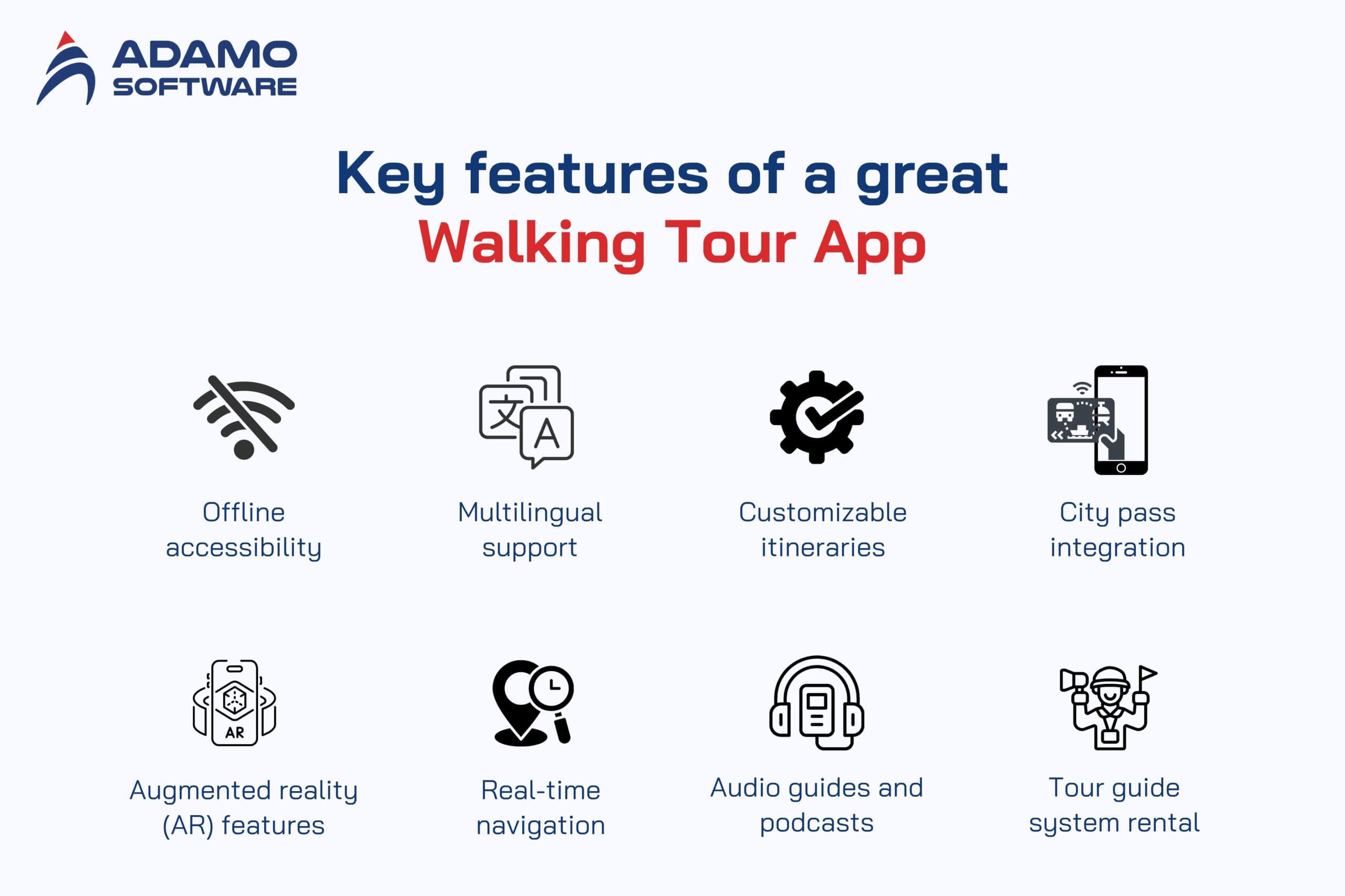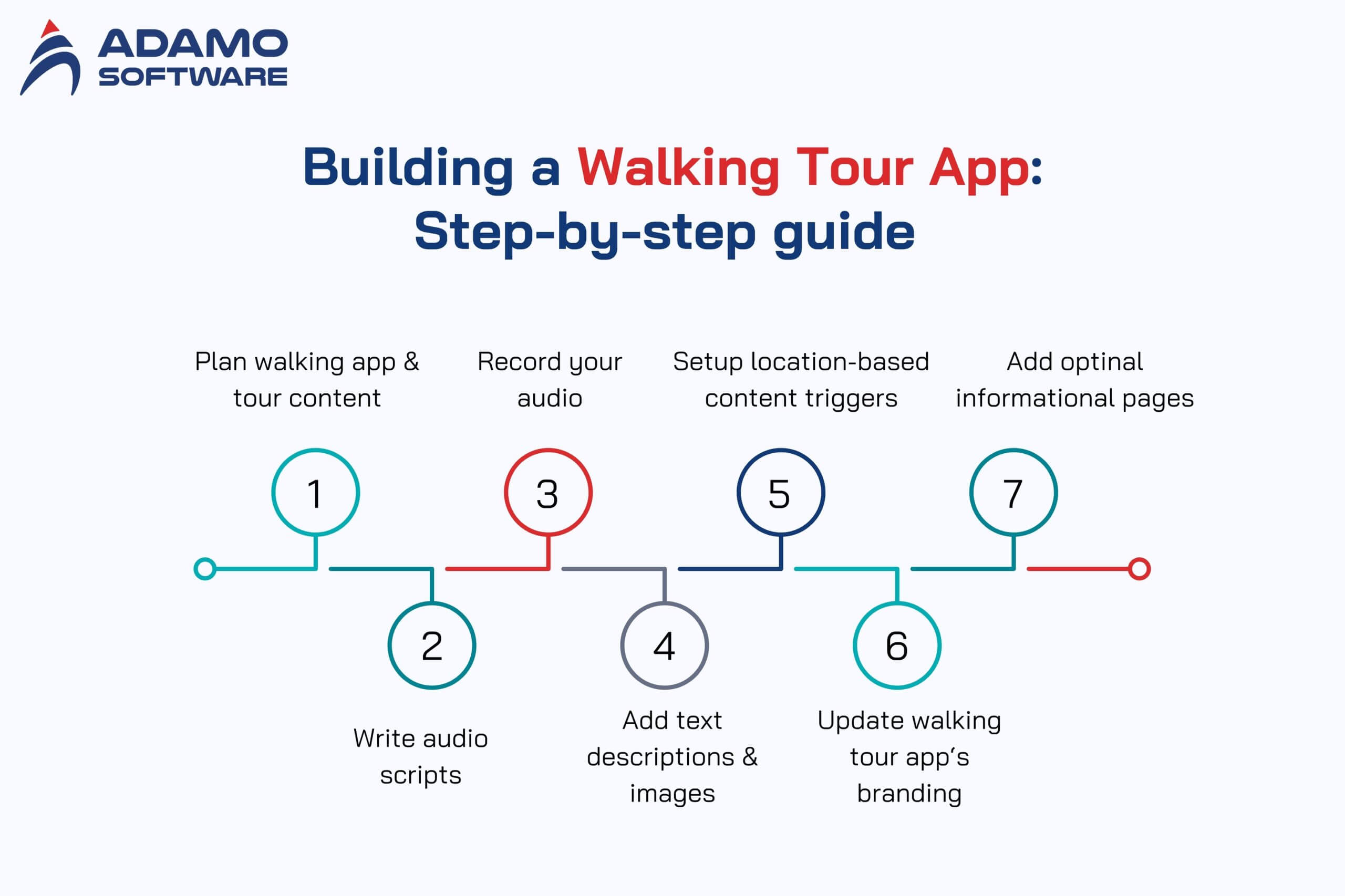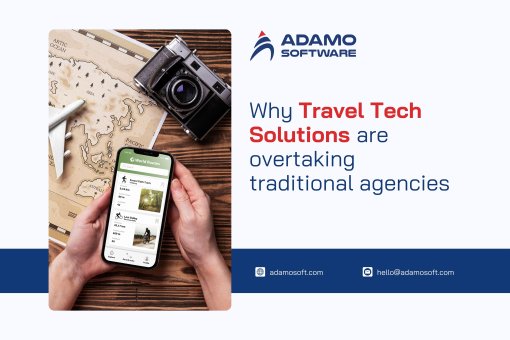Walking tour app: Key features & step-by-step guide to build one

A walking tour app is useful for travelers to tailor their trip requirements. Let Adamo Software discuss some insights, features, and how to develop the app.
Solo travel has become a trend, and solo travelers may want an app to tailor their trip requirements. Many apps can help users explore urban spaces or cultural destinations more flexibly and proactively. The walking tour app is among these useful apps. Instead of following a traditional tour guide, users just need to install the application on their phone and choose the itinerary, time, and speed of the tour themselves. So, what is a walking tour app and its must-have features? Let Adamo Software answer these questions.
Through this blog post, besides getting some insights about the walking tour app, you will also know about the benefits of travel app development. All information has been thoroughly researched and updated to the latest trends. So, let’s read our blog post and find some useful information!
I. What is a walking tour app?
A walking tour app is a mobile application that leverages GPS and multimedia to lead users through pre-planned routes and notable locations. With just a smartphone, you can explore cities, landmarks, or natural trails at your own pace, anytime and anywhere. If you like, you can travel to any place you want to explore without joining a guided group tour.
Let’s see the table below for some typical functions that a walking tour app provides.
| No | Functions | Descriptions |
| 1 | GPS-enabled navigation
|
|
| 2 | Audio storytelling |
|
| 3 | Visual content |
|
| 4 | Offline functionality |
|
| 5 | Personalized exploration |
|
Unlike standard guided tours with fixed schedules and group formats, a walking tour app is more flexible, private, and can be customized. If you are a solo traveler who loves self-guided adventures, this app is ideal for you. Besides, it is also a perfect fit for locals who want to discover their city’s hidden gems, travelers looking for socially distanced activities, and tour providers and tourism boards aiming to digitize their offerings.
In general, a walking tour app is an indispensable choice when you travel, no matter if you are traveling alone or with your friends and family. It turns your smartphone into a portable tour guide, redefining the modern traveler’s interaction with destinations. Let’s keep reading to see the key features of this app.
II. Key Features of a great Walking Tour App
A walking tour app must integrate many smart and user-friendly features to bring enjoyable and convenient traveling experiences for tourists. These features help users explore an attraction more easily, personalize their journey, and optimize usage even without an internet connection. Let’s explore some outstanding features that a modern walking tour app must have with us!

1. Offline Accessibility
Offline accessibility is one of the most important features of a walking tour app. Sometimes, users may travel to the region with unstable Internet connection. Thus, this feature is essential for users to experience their journey and the app without interruption.
Crucially, the app needs to support offline downloads of maps, audio guides, and other content. Thanks to this, users can easily monitor their journey, follow instructions, and explore locations even offline.
This feature boosts convenience and extends battery life by eliminating the need for constant network connections to download data. Besides, users may feel more secure, as they can manage their journey independently without depending on external technical factors.
2. Multilingual Support
When you develop a walking tour app, do you want to target users globally? If yes, your app may want to have a multilingual support feature. This helps your app become more friendly and access more users worldwide. The app should offer its interface, commentary, directions, and location information in multiple popular languages, such as English, French, Chinese, Spanish, etc.
The multilingual support breaks down language barriers, making it easy for both solo travelers and groups to understand the significance and history of monuments. With this function, users can freely select suitable language in just some simple steps, thereby personalizing users’ experiences. The multilingual support feature of the walking tour app helps users better understand the culture, history, and significance of destinations. Besides, it also fosters a sense of familiarity that boosts users’ confidence and satisfaction throughout the journey.
3. Customizable Itineraries
Each traveler may have their own travel preferences. Some may love exploring history while others love nature, food, or street art. Some may like adventurous activities while some just want to travel for healing and relaxation. Thus, the customizable itineraries feature is extremely essential for personalizing user experience.
With this feature, your walking tour app may enable users to select attractions based on their favorite theme, itinerary, available time, desired travel distance, etc. The app will automatically create a suitable itinerary, saving users’ time on planning and ensuring that the itinerary fits their preferences.
In addition, this feature allows users to add or remove destinations in their itinerary flexibly and easily. Users can adjust the itinerary anytime, even when they are on the journey without losing data or having to start over.
4. City Pass Integration
City passes in most urban areas come with benefits like discounted attraction entry and public transportation access. With the city pass integration feature, your walking tour app can bring practical value to users, especially those who want to save costs and make the most of tourism services at the destination.
Your app should integrate city passes seamlessly, allowing users to view their benefits directly within the application. Your users can easily access offers such as free admission tickets, discounts on restaurants, public transport, or local experiences, etc.
The app can also suggest attractions that are included in the City Pass offer list, thereby building an optimal itinerary in terms of both experience and budget. This not only saves users time but also increases flexibility in choosing activities.
5. Augmented Reality (AR) Features
The walking tour app can take advantage of the augmented reality (AR) features to differentiate it from other travel apps. AR features enable more vivid and engaging user interaction with the surrounding environment. It can recreate historical structures, famous people, or important events right in the actual location.
When users point their phone at a location, the app can overlay virtual information like 3D models, animations, or narrated videos onto the real landscape. This makes the journey much more intuitive and engaging than simply reading text descriptions or listening to audio.
AR is also an effective educational tool, especially for young travelers or families with small children. Instead of simply walking around, they will have a chance to interact with things and events in the destination through the AR technology. This contributes to increasing the level of user satisfaction and engagement with the tourist destination.
6. Real-Time Navigation
Real-time navigation is an indispensable feature of an effective walking tour app. This feature helps users easily identify their current location, monitor their selected routes, and ensure that they won’t get lost when moving through unfamiliar streets or crowded areas.
With the real-time navigation feature, users can be alerted when taking a wrong turn or deviating from the set itinerary. This is especially useful when the tour includes multiple stops or requires continuous movement between landmarks. In addition, the real-time navigation system can also update traffic, weather, or current events, suggesting appropriate changes based on actual conditions. This ensures the tour itinerary is not only accurate but also flexible, readily adapting to changing surroundings.
7. Audio Guides and Podcasts
Your walking tour app may want to have the audio guides and podcasts feature, which provides detailed descriptions of landmarks and attractions. Instead of just reading information on a screen, users can wear headphones and walk while listening to interesting stories, fascinating history, or local anecdotes told vividly.
Beyond traditional narration, incorporating travel podcasts into walking tour apps enriches the journey of discovery with added depth and emotion. Through podcasts, users can listen to stories from local residents, artists, veteran guides, or even tourists who have visited the location. These contents are both entertaining and culturally enriching. Thanks to this, they may feel that they are really on a trip.
8. Tour Guide System Rental
The tour guide system rental feature in your walking tour app provides an ideal solution for groups of tourists, especially on tours with a live guide. To avoid loudspeakers or difficulty hearing in crowded areas, the app seamlessly connects tour guides and listeners through headphones or personal devices via Bluetooth or its internal network.
The rental system can operate directly within the app, allowing the guide to broadcast content via a microphone or mobile device, and listeners to receive clear audio signals even from several meters away. This enhances the tour experience, making it more professional, respectful, and convenient, particularly in quiet settings such as museums, religious sites, or residential areas.
In general, a qualified walking tour app must integrate all the essential features to bring a comprehensive user experience. These features make the app an effective navigation tool for tourists’ journeys.
III. Building a Walking Tour App: Step-by-step guide
If you want to develop an effective walking tour app, you may want to have a clear and systematic process, from the idea stage to the actual implementation. Every step in this process is crucial for ensuring the app runs smoothly, is user-friendly, and meets market demands. Here is a step-by-step guide to help you build a quality and competitive walking tour app.

1. Planning the walking path and tour content
The first step to build a walking tour app is to plan the walking path and tour content. You may want to identify the important sites, assets, or artwork you want to feature, as well as the optimal route through them. Choosing an itinerary should be based on many factors such as cultural and historical value, safety, accessibility, and diversity of experiences. Thus, you should survey the field to plan appropriate stops with reasonable distances and easy navigation to ensure a seamless journey.
Besides, the tour content also needs to be considered. Each location should have a clear, easy-to-understand explanation, combined with storytelling elements to increase appeal and evoke emotions. The content can include text, images, audio, video, or even 3D models to create a more vivid experience. Let’s collaborate with all stakeholders and begin outlining ideas on a physical or virtual whiteboard.
2. Write audio scripts
Once you have identified the walking path and tour content, you will continue your walking tour app development with writing audio scripts. Since this is the content users will hear directly, it’s crucial to craft it carefully, ensuring it conveys accurate information while feeling lively, relatable, and easy to grasp.
You should write the audio scripts and have all stakeholders approve them. When developing your scripts, think about how many voiceover artists will be involved. Let’s consider if you need only one single artist to read each script in its entirety, or you will use multiple voiceover artists to play different roles and tell a story.
Your audio scripts should be written in a natural narrative style, avoiding academic language. Each audio track should be 3 to 5 minutes. You can extend the audio track based on the time it takes to walk from one stop to the next.
3. Record your audio
Next, you will record your audio. This is an essential step in developing your walking tour app that helps to bring authentic and professional experience to users. Sound quality has a direct impact on the listener’s perception, so you should use high-quality recording equipment and record in a quiet environment to avoid noise or echo.
You may want to carefully check each recording to correct the volume, eliminate pronunciation errors, or remove unnecessary silence. Good audio can convey essential information and help users feel connected to the destination through each story told through sound.
4. Add text descriptions and images
The next step in developing your walking tour app is to create the additional content needed to accompany your tour. To create an attractive multimedia app, you should also include an image for each stop. This helps visitors match what they’re seeing in real life with the correct audio content. You should use high-quality photos that clearly show the location’s prominent features, along with short captions if necessary. You can also add elements such as mini-maps, area diagrams, or historical images to make it more appealing.
The text description should be short, easy to understand, yet informative, summarizing the explanatory content or providing additional details like the year of construction, architecture, or related events. The writing style should be narrative and avoid writing like an academic document.
5. Setup location-based content triggers
If you want to enhance user experience, you may want to add the setup location-based content triggers feature for your walking tour app. This feature can alert visitors to nearby content or automatically advance the tour audio as they explore the site.
It’s often practical to use Bluetooth technology for walking tours due to its effective range within a smaller radius. Conversely, driving tours generally utilize GPS. You need to assign geo-tags to each location in the tour, then set a trigger distance. For example, when the user gets within 20–30 meters of the location, the content will be played automatically.
Overall, setting up local-based content helps users personalize the journey and arrange the itinerary conveniently. This is especially useful in cities with many attractions close together.
6. Updating the walking tour app’s branding
After completing the core content and features, you will have to design and update your walking tour app identity. This step helps your app become professional, consistent, and memorable. Creating an on-brand digital experience is key to making the app feel like a seamless part of your organization.
Now, it’s time for you to design a logo, color palette, fonts, and app interface that matches the theme of each tour. Some outstanding themes include history, art, local exploration, culinary tourism, etc. The interface should be minimalist, clear, and easy to navigate while walking and using the phone.
7. Adding optional informational pages
Your final step is to add additional information pages to support a more comprehensive user experience. You may want to include an “About” or “Info” page in your walking tour app. This page is ideal for sharing contact details, operating hours, and FAQs. Besides, you can explain how to navigate the app, use maps, adjust audio, download offline content, or change languages.
If you want to use your app to sell tickets for additional experiences, you might want to create a separate page for that. You can embed a payment processor for various transactions like tickets, dinner reservations, memberships, and donations.
These pages will appear in your app menu, allowing users to navigate to them at any time. They should be short, easy to read, seamlessly integrated into the overall interface, and not interrupt the main experience.
IV. How Adamo Software helps build smart travel apps
Are you looking for a partner to help you build your walking tour app? As one of Vietnam’s leading technology companies in Vietnam with many years of experience working in the travel software development industry, Adamo Software can be your ideal choice. Beyond programming services, we also accompany you from idea generation, user experience design, to product deployment and optimization. Let’s see how we can help.

1. Consulting and building optimal application architecture
Adamo Software supports customers in consulting and building the walking tour app architecture from scratch, ensuring the system structure is suitable for the goals and scale of operation. This architecture allows the app to operate smoothly, scale easily, and seamlessly integrate features such as GPS navigation, automatic audio playback, or offline content storage.
2. Designing intuitive, user-friendly UI/UX
Regarding design, Adamo’s technical team will ensure your tour walking app’s interface is intuitive, easy to use, and mobile-friendly. Especially, the design will be optimized for walking behavior, allowing users to explore and use the app flexibly.
3. Developing Content Management System (CMS)
Besides designing UI/UX, we also help you build the content management system. This system allows you to update the tour information, add images, edit scripts, and manage itineraries easily.
4. Integrating new technologies
Adamo Software will integrate new technologies into your walking tour app, such as interactive maps, artificial intelligence (AI) and augmented reality (AR). These technologies contribute to enhancing your users’ experience. For example, AI can suggest personalized tour routes based on visitors’ preferences or time, while AR allows users to see 3D models of historical buildings on the spot.
5. Providing long-term maintenance service and periodic upgrades
Beyond designing, we also support long-term maintenance service and periodic upgrades. We monitor system performance, promptly fix errors, and update new technologies to improve user experience. In addition, if you want to expand any feature of your walking tour app, develop new tours or integrate modern technology, we are always ready to support you.
Still hesitating whether to choose Adamo Software to help you build your walking tour app? Let’s contact us for more detailed information!











